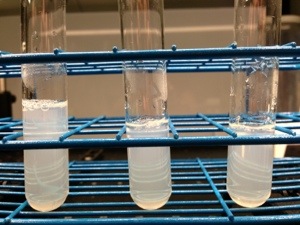So I’ve noticed that no matter what, there is some bacterial contamination, and based on an experiment I did with the reconstituted yeast, it seems the contamination exists there. After doing some research, it seems I can add antibiotics to the YPD without affecting yeast growth and preventing bacterial growth. So today I’m doing just that. I’ll take a picture of tomorrow’s culture to reveal whether or not this method works against the bacteria, and if it impacts the yeast growth.
It turns out that I have ampicillin as a powder. So I added 20ml of water to it to bring it to a concentration of 10mg/ml. According to a protocol I found on my old stomping grounds (openwetware.org), I need to add 50ul to 10ml of YPD to get a final concentration of 50ug/ml.
